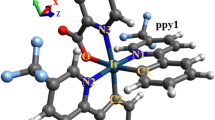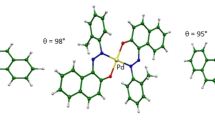Abstract
The electronic structures and spectroscopic properties of two complexes [M(pic)3] (M = Ir, Rh) containing picolinate as bidentate ligands have been calculated by means density functional theory (DFT) and time-dependent DFT/TD-DFT using three hybrid functionals B3LYP, PBE0 and mPW1PW91. The PBE0 and mPW1PW91 functionals, which have the same HF exchange fraction (25%), give similar results and do not differ drastically from B3LYP results. Calculated geometric parameters of the complexes are in good agreement with the available experimental data. The UV absorptions observed in acetonitrile were assigned on the basis of singlet state transitions. The most intense band observed in the UV-C region corresponds to ligand-to-ligand charge transfer states (LLCT) in both complexes. The theoretical spectrum of the rhodium complex is characterized by a large degree of mixing between metal-to-ligand-charge-transfer (MLCT), LLCT and metal centered (MC) states in the UV-A region. The presence of low-lying excited states with MC character affects the absorption spectrum under spin-orbit coupling (SOC) effects and play important roles in the photochemical properties.

Frontier molecular orbital diagram of mer-M(pic)3 (M=Ir, Rh).






Similar content being viewed by others
References
Alagona G, Ghio C, Rocchiccioli S (2007) Computational prediction of the regio- and diastereoselectivity in a rhodium-catalyzed hydroformylation/cyclization domino process. J Mol Model 13:823–837. https://doi.org/10.1007/s00894-007-0205-8
Xu S, Wang J, Xia H, Zhao F and Wang Y (2015) Computational prediction for emission energy of iridium (III) complexes based on TDDFT calculations using exchange-correlation functionals containing various HF exchange percentages. J Mol Model 21:22. https://doi.org/10.1007/s00894-014-2557-1
Zhang T-T, Qi X-X, Jia J, Wu H-S (2012) Tuning electronic structure and photophysical properties of [Ir(ppy)2(py)2]+ by substituents binding in pyridyl ligand: a computational study. J Mol Model 18:4615–4624. https://doi.org/10.1007/s00894-012-1462-8
Chen M, Serna P, Lu J, Gates BC, Dixon DA (2015) Molecular models of site-isolated cobalt, rhodium, and iridium catalysts supported on zeolites: ligand bond dissociation energies. Comput Theor Chem 1074:58–72. https://doi.org/10.1016/j.comptc.2015.09.004
Meng Q, Shen W, Li M (2011) Mechanism of intermolecular hydroacylation of vinylsilanes catalyzed by a rhodium(I) olefin complex: a DFT study. J Mol Model 18:1229–1239. https://doi.org/10.1007/s00894-011-1151-z
Ahn SY, Ha Y (2009) The blue phosphorescent iridium complexes containing new triazole ligands for OLEDs. Mol Cryst Liq Cryst 504:59–66. https://doi.org/10.1080/15421400902939504
Morello G R (2017) Accurate prediction of emission energies with TD-DFT methods for platinum and iridium OLED materials. J Mol Model 23:174. https://doi.org/10.1007/s00894-017-3348-2
Park HR, Ha Y (2012) Comparison of emission characteristics with 4-, 5-, 6-membered iridium complexes for OLEDs. Mol Cryst Liq Cryst 563:246–256. https://doi.org/10.1080/15421406.2012.689729
Park S-Y, Kim H-K, Shin D-M (2016) Synthesis and characterization of red phosphorescent iridium(III) complexes based on electron-acceptor modulation of main ligand for high efficiency organic light-emitting diodes. Mol Cryst Liq Cryst 636:38–44. https://doi.org/10.1080/15421406.2016.1200941
Simpson PV, Schmidt C, Ott I, Bruhn H, Schatzschneider U (2013) Synthesis, cellular uptake and biological activity against pathogenic microorganisms and cancer cells of rhodium and iridium N-heterocyclic carbene complexes bearing charged substituents. Eur J Inorg Chem 2013:5547–5554. https://doi.org/10.1002/ejic.201300820
Almodares Z, Lucas SJ, Crossley BD, Basri AM, Pask CM, Hebden AJ, Phillips RM, McGowan PC (2014) Rhodium, iridium, and ruthenium half-sandwich picolinamide complexes as anticancer agents. Inorg Chem 53:727–736. https://doi.org/10.1021/ic401529u
Leung C-H, Zhong H-J, Chan DS-H, Ma D-L (2013) Bioactive iridium and rhodium complexes as therapeutic agents. Coord Chem Rev 257:1764–1776. https://doi.org/10.1016/j.ccr.2013.01.034
Seth SK, Mandal S, Purkayastha P, Gupta P (2015) Cyclometalated mono and dinuclear rhodium(III) and iridium(III) complexes with imidazolyl phenanthrolines: synthesis and, photophysical and electrochemical characterization. Polyhedron 95:14–23. https://doi.org/10.1016/j.poly.2015.04.011
Jayabharathi J, Jayamoorthy K, Thanikachalam V (2014) Synthesis, photophysical and electroluminescent properties of green organic light emitting devices based on novel iridium complexes containing benzimidazole ligands. J Organomet Chem 761:74–83. https://doi.org/10.1016/j.jorganchem.2014.03.002
Xu J-X, Xue H, Zou H, Ke S-W, Qin T, Wang X, Shen X, Zhu D-R (2016) Syntheses and characterizations of 5-nitro-2-(3′,5′-di(trifluoromethyl)phenyl)pyridyl-containing iridium(III) complexes and the two-band white photoluminescence properties in solution. J Coord Chem 69:3172–3181. https://doi.org/10.1080/00958972.2016.1230671
Yi S, Kim J-H, Cho Y-J, Lee J, Choi T-S, Cho DW, Pac C, Han W-S, Son H-J, Kang SO (2016) Stable blue phosphorescence iridium(III) cyclometalated complexes prompted by intramolecular hydrogen bond in ancillary ligand. Inorg Chem 55:3324–3331. https://doi.org/10.1021/acs.inorgchem.5b02511
Minaev B, Minaeva V, Ågren H (2009) Theoretical study of the cyclometalated iridium(III) complexes used as chromophores for organic light-emitting diodes. J Phys Chem A 113:726–735. https://doi.org/10.1021/jp807429h
Minaev B, Baryshnikov G, Agren H (2014) Principles of phosphorescent organic light emitting devices. Phys Chem Chem Phys 16:1719–1758. https://doi.org/10.1039/c3cp53806k
Ko S-B, Lu J-S, Kang Y, Wang S (2013) Impact of a picolinate ancillary ligand on phosphorescence and fluoride sensing properties of BMes2-functionalized platinum(II) compounds. Organometallics 32:599–608. https://doi.org/10.1021/om301112u
Basu S, Peng S-M, Lee G-H, Bhattacharya S (2005) Synthesis, structure and electrochemical properties of tris-picolinate complexes of rhodium and iridium. Polyhedron 24:157–163. https://doi.org/10.1016/j.poly.2004.10.015
Becke AD (1993) Density-functional thermochemistry. III. The role of exact exchange. J Chem Phys 98:5648. https://doi.org/10.1063/1.464913
Hohenberg P, Kohn W (1964) Inhomogeneous electron gas. Phys Rev 136:B864–B871. https://doi.org/10.1103/physrev.136.b864
Lee C, Yang W, Parr RG (1988) Development of the Colle-Salvetti correlation-energy formula into a functional of the electron density. Phys Rev B 37:785–789. https://doi.org/10.1103/physrevb.37.785
Adamo C, Barone V (1999) Toward reliable density functional methods without adjustable parameters: the PBE0 model. J Chem Phys 110:6158. https://doi.org/10.1063/1.478522
Adamo C, Barone V (1998) Exchange functionals with improved long-range behavior and adiabatic connection methods without adjustable parameters: the mPW and mPW1PW models. J Chem Phys 108:664. https://doi.org/10.1063/1.475428
Binning RC, Curtiss LA (1990) Compact contracted basis sets for third-row atoms: Ga-Kr. J Comput Chem 11:1206–1216. https://doi.org/10.1002/jcc.540111013
Krishnan R, Binkley JS, Seeger R, Pople JA (1980) Self-consistent molecular orbital methods. XX. A basis set for correlated wave functions. J Chem Phys 72:650. https://doi.org/10.1063/1.438955
McLean AD, Chandler GS (1980) Contracted Gaussian basis sets for molecular calculations. I. Second row atoms, Z=11–18. J Chem Phys 72:5639. https://doi.org/10.1063/1.438980
Hay PJ, Wadt WR (1985) Ab initio effective core potentials for molecular calculations. Potentials for the transition metal atoms Sc to Hg. J Chem Phys 82:270. https://doi.org/10.1063/1.448799
Hay PJ, Wadt WR (1985) Ab initio effective core potentials for molecular calculations. Potentials for K to Au including the outermost core orbitals. J Chem Phys 82:299. https://doi.org/10.1063/1.448975
Cancès E, Mennucci B, Tomasi J (1997) A new integral equation formalism for the polarizable continuum model: theoretical background and applications to isotropic and anisotropic dielectrics. J Chem Phys 107:3032. https://doi.org/10.1063/1.474659
Cossi M, Barone V, Mennucci B, Tomasi J (1998) Ab initio study of ionic solutions by a polarizable continuum dielectric model. Chem Phys Lett 286:253–260. https://doi.org/10.1016/s0009-2614(98)00106-7
Casida ME (1995) Time-dependent density functional response theory for molecules. In: Chong DP (ed) Recent advances in density functional methods, part I. World Scientific, Singapore, pp 155–192
Casida ME (1996) Time-dependent density functional response theory of molecular systems: theory, computational methods, and functionals. In: Seminario JM (ed) Recent developments and applications of modern density functional theory. Elsevier, Amsterdam, pp 391–439
Runge E, Gross EKU (1984) Density-functional theory for time-dependent systems. Phys Rev Lett 52:997–1000. https://doi.org/10.1103/physrevlett.52.997
Frisch MJ, Trucks GW, Schlegel HB, Scuseria GE, Robb MA, Cheeseman JR, Scalmani G, Barone V, Mennucci B, Petersson GA, Nakatsuji H, Caricato M, Li X, Hratchian HP, Izmaylov AF, Bloino J, Zheng G, Sonnenberg JL, Hada M, Ehara M, Toyota K, Fukuda R, Hasegawa J, Ishida M, Nakajima T, Honda Y, Kitao O, Nakai H, Vreven T, Montgomery Jr JA, Peralta JE, Ogliaro F, Bearpark M, Heyd JJ, Brothers E, Kudin KN, Staroverov VN, Kobayashi R, Normand J, Raghavachari K, Rendell A, Burant JC, Iyengar SS, Tomasi J, Cossi M, Rega N, Millam JM, Klene M, Knox JE, Cross JB, Bakken V, Adamo C, Jaramillo J, Gomperts R, Stratmann RE, Yazyev O, Austin AJ, Cammi R, Pomelli C, Ochterski JW, Martin RL, Morokuma K, Zakrzewski VG, Voth GA, Salvador P, Dannenberg JJ, Dapprich S, Daniels AD, Foresman JB, Ortiz JV, Cioslowski J, Fox DJ (2009) Gaussian 09. Gaussian, Inc., Wallingford
O'Boyle NM, Tenderholt AL, Langner KM (2008) cclib: a library for package-independent computational chemistry algorithms. J Comput Chem 29:839–845. https://doi.org/10.1002/jcc.20823
Hanwell MD, Curtis DE, Lonie DC, Vandermeersch T, Zurek E, Hutchison GR (2012) Avogadro: an advanced semantic chemical editor, visualization, and analysis platform. J Cheminform 4:17. https://doi.org/10.1186/1758-2946-4-17
Farrugia LJ (2012) WinGXandORTEP for windows: an update. J Appl Crystallogr 45:849–854. https://doi.org/10.1107/s0021889812029111
Hakimi M (2013) Structural and spectral characterization of a chromium(III) picolinate complex: introducing a new redox reaction. J Korean Chem Soc 57:721–725. https://doi.org/10.5012/jkcs.2013.57.6.721
Li X, Zhang Q, Tu Y, Ågren H, Tian H (2010) Modulation of iridium (III) phosphorescence via photochromic ligands: a density functional theory study. Phys Chem Chem Phys 12:13730. https://doi.org/10.1039/c0cp00564a
Nie D, Liu Z, Bian Z, Huang C (2008) Assessment of density functionals for the investigation of iridium(III) complexes. J Mol Struct 861:97–102. https://doi.org/10.1016/j.theochem.2008.04.033
Zhang G, Musgrave CB (2007) Comparison of DFT methods for molecular orbital eigenvalue calculations. J Phys Chem A 111:1554–1561. https://doi.org/10.1021/jp061633o
Baerends EJ, Gritsenko OV, van Meer R (2013) The Kohn-Sham gap, the fundamental gap and the optical gap: the physical meaning of occupied and virtual Kohn-Sham orbital energies. Phys Chem Chem Phys 15:16408. https://doi.org/10.1039/c3cp52547c
Brahim H, Daniel C (2014) Structural and spectroscopic properties of Ir(III) complexes with phenylpyridine ligands: absorption spectra without and with spin-orbit-coupling. Comput Theor Chem 1040–1041:219–229. https://doi.org/10.1016/j.comptc.2014.01.030
Brahim H, Daniel C, Rahmouni A (2011) Spin-orbit absorption spectroscopy of transition metal hydrides: a TD-DFT and MS-CASPT2 study of HM(CO)5 (M = Mn, Re). Int J Quantum Chem 112:2085–2097. https://doi.org/10.1002/qua.23219
Tsai H-R, Lu K-Y, Lai S-H, Fan C-H, Cheng C-H, Chen IC (2011) Metal–ligand bonding strength of fluoro-substituted cyclometalated iridium(III) complexes from raman and infrared spectra. J Phys Chem C 115:17163–17174. https://doi.org/10.1021/jp204130a
Gipson K, Stevens K, Brown P, Ballato J (2015) Infrared spectroscopic characterization of photoluminescent polymer nanocomposites. J Spectrosc 2015:1–9. https://doi.org/10.1155/2015/489162
Gharah N, Drew MGB, Bhattacharyya R (2009) Synthesis and catalytic epoxidation potentiality of oxodiperoxo molybdenum(VI) complexes with pyridine-2-carboxaldoxime and pyridine-2-carboxylate: the crystal structure of PMePh3[MoO(O2)2(PyCO)]. Transition Met Chem (London) 34:549–557. https://doi.org/10.1007/s11243-009-9228-6
Hnatejko Z, Dutkiewicz G, Kubicki M, Lis S (2013) New complexes of cobalt(II) ions with pyridinecarboxylic acid N-oxides and 4,4′-byp. J Mol Struct 1034:128–133. https://doi.org/10.1016/j.molstruc.2012.08.044
Świderski G, Kalinowska M, Wojtulewski S, Lewandowski W (2006) Experimental (FT-IR, FT-Raman, 1H NMR) and theoretical study of magnesium, calcium, strontium, and barium picolinates. Spectrochim Acta A 64:24–33. https://doi.org/10.1016/j.saa.2005.06.034
Author information
Authors and Affiliations
Corresponding author
Electronic supplementary material
ESM 1
(DOCX 35 kb)
Rights and permissions
About this article
Cite this article
Brahim, H., Haddad, B., Brahim, S. et al. DFT/TDDFT computational study of the structural, electronic and optical properties of rhodium (III) and iridium (III) complexes based on tris-picolinate bidentate ligands. J Mol Model 23, 344 (2017). https://doi.org/10.1007/s00894-017-3517-3
Received:
Accepted:
Published:
DOI: https://doi.org/10.1007/s00894-017-3517-3




